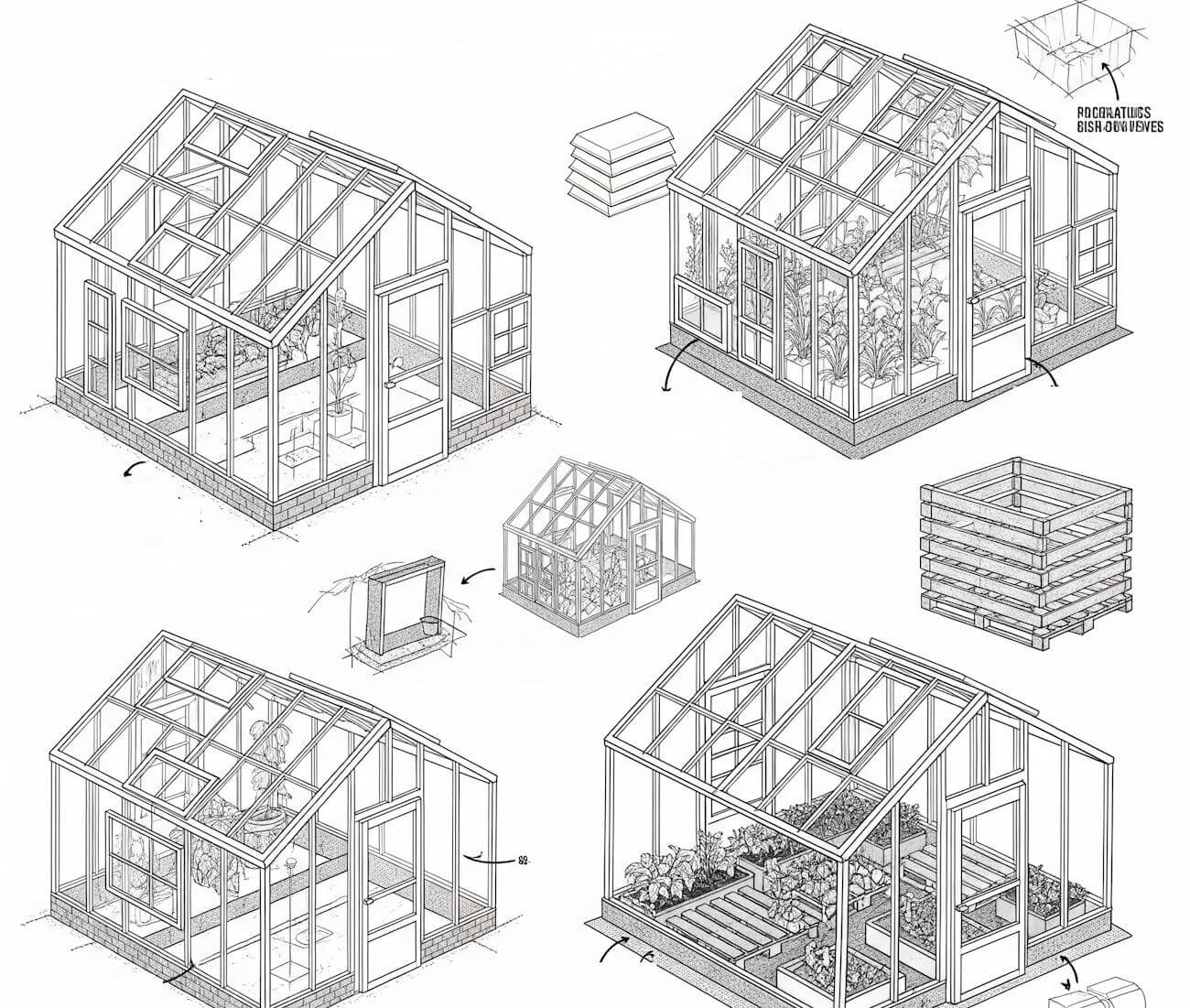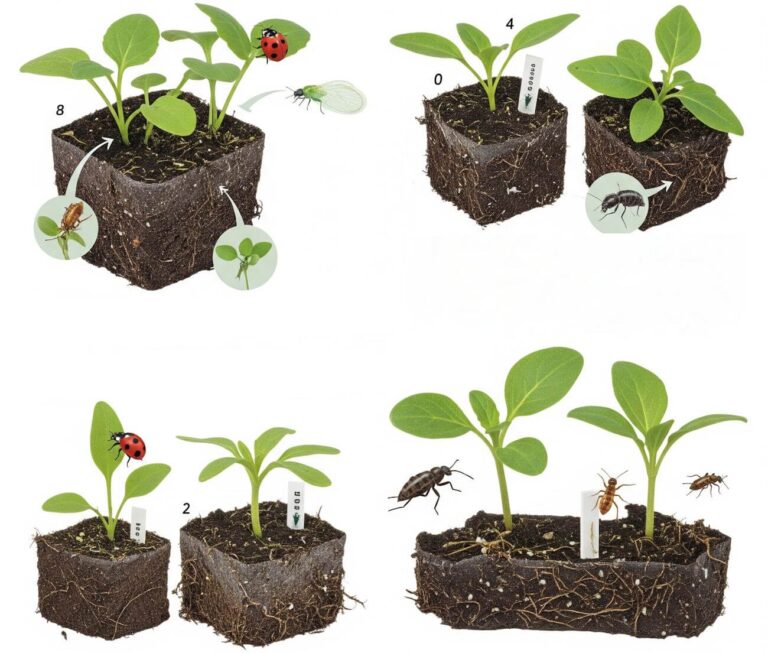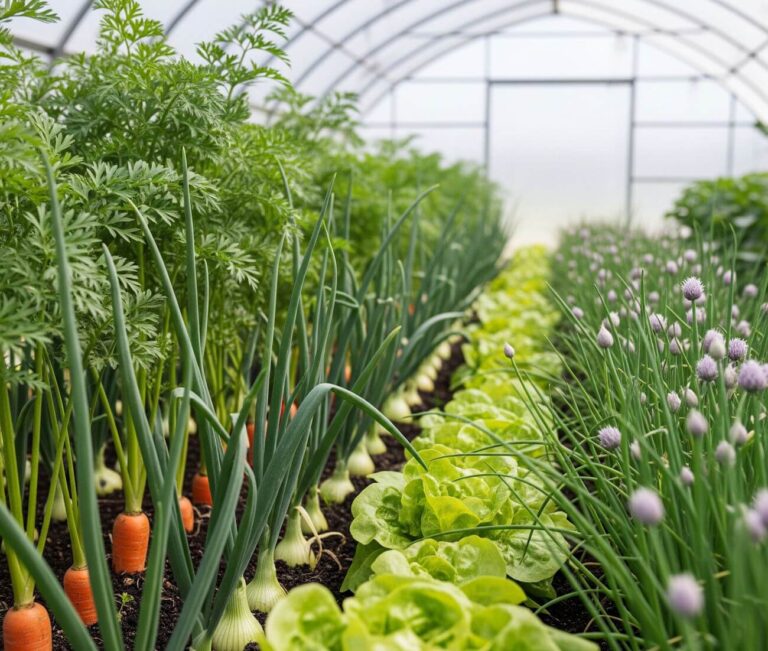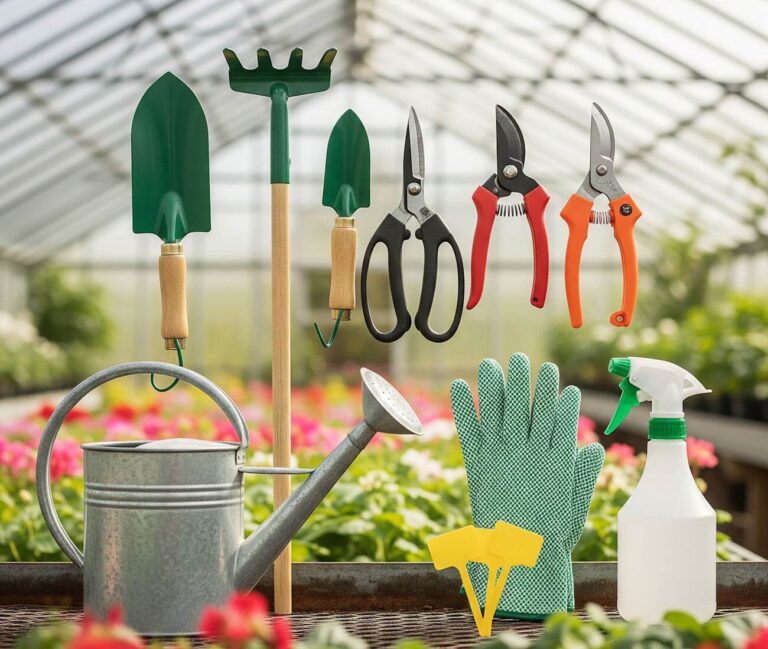Introduction to Backyard Greenhouses
Backyard greenhouses have become an increasingly popular choice for gardening enthusiasts and urban farmers alike, offering a unique opportunity to cultivate plants in a controlled environment. These structures, whether temporary or permanent, provide numerous advantages that can significantly enhance one’s gardening experience. One of the most notable benefits is the ability to extend the growing season. By utilizing a greenhouse, gardeners can initiate planting earlier in the spring and prolong the harvest well into the fall or even winter, depending on the climate.
Moreover, a greenhouse offers protection from harsh weather conditions. It shields plants from extreme temperatures, strong winds, and heavy rain, which can damage delicate seedlings or mature plants. Additionally, having a controlled environment means that pests and diseases, which can threaten the health of plants, are less likely to invade. By establishing a backyard greenhouse, gardeners can create a sanctuary where their plants can thrive without the usual external threats faced in an open garden.
Furthermore, greenhouses promote enhanced plant growth by allowing for effective regulation of temperature, humidity, and light. This optimized environment can result in healthier plants, increased yields, and overall improved quality of produce. They can also serve as a space for experimentation, enabling gardeners to try growing a wider variety of plants that may not typically thrive in their local climatic conditions.
Creating a backyard greenhouse on a budget is indeed possible, making it accessible to a broader audience of gardening enthusiasts. Implementing cost-effective materials and design solutions can help individuals achieve their gardening dreams without the financial strain often associated with such projects. By following a step-by-step guide, anyone can embark on the journey of constructing their own affordable greenhouse, facilitating a rewarding and sustainable approach to gardening.
Choosing the Right Location
Selecting the ideal location for your backyard greenhouse is a critical step that can significantly impact the success of your gardening efforts. One of the foremost considerations is sunlight exposure. A greenhouse thrives best with ample natural light, so it is essential to place it in a spot that receives at least six to eight hours of direct sunlight each day. Therefore, examining the path of the sun throughout the day allows you to identify areas free from obstructions such as trees, tall buildings, or other structures that may cast shadows during peak hours.
Wind direction is another vital factor to consider. Locating your greenhouse in a sheltered area can protect delicate plants from harsh winds that can cause structural damage or impede pollination. A natural windbreak, such as a fence or row of shrubs, can be beneficial in providing a stable environment within your greenhouse.
Accessibility is equally important when choosing a location for your greenhouse. It should be conveniently situated near water sources to facilitate easy irrigation and maintenance. This is particularly crucial for individuals who may want to set up automated watering systems. Moreover, the location should allow for easy access from your home, ensuring that you can quickly tend to your plants without unnecessary hassle.
Proper drainage cannot be overlooked during this decision-making process. Ensure that the site does not collect standing water, as poor drainage can lead to waterlogging and root rot. Building the greenhouse on a slight slope can help direct excess water away, creating a healthier environment for your plants. By taking these factors into consideration, you can select an optimal location that supports the healthy growth of your greenhouse plants.
Selecting Affordable Materials
When embarking on the journey to construct a greenhouse on a budget, selecting the right materials is crucial. Cost-effective options not only reduce the overall expenditure but also contribute to a sustainable building approach. Among the best options for a budget-friendly greenhouse are reclaimed wood, PVC pipes, and clear plastic sheeting.
Reclaimed wood is an excellent choice for the framing and structural components of your greenhouse. This material not only reduces waste but also adds an aesthetically pleasing rustic charm. Sourcing reclaimed wood can be achieved through local builders’ surplus stores, online marketplaces, or even through local advertisements where people sell leftover construction materials. Utilizing this wood ensures that you are making an environmentally responsible choice while significantly cutting down costs.
PVC pipes are another affordable and versatile material to consider. These pipes serve well for the greenhouse’s frame, particularly in small-scale setups. They are lightweight, durable, and resistant to weather fluctuations, making them an ideal choice for a backyard greenhouse. PVC also allows for easy assembly and can be disassembled and repurposed if necessary. Most hardware stores stock PVC pipes at reasonable prices, and you may even find surplus or second-hand options available locally.
In addition to structural materials, clear plastic sheeting is essential for greenhouse glazing. This material is lightweight and can be easily applied to frames, providing the necessary light while retaining warmth. It is available in various thicknesses, so you can choose a type that best meets your budget and climate needs. Purchasing from local suppliers or discount stores can further ensure that you find effective solutions at lower prices.
To maximize savings, consider checking local classifieds, online platforms, and community groups for second-hand supplies. By being resourceful and selecting affordable materials, you can effectively create a greenhouse that fits both your budget and gardening aspirations.
Design Ideas for a Budget Greenhouse
Building a backyard greenhouse on a budget doesn’t have to compromise quality or functionality. There are several innovative design ideas that provide effective growing environments while remaining cost-efficient. Among the most popular structures are hoop houses. These are simple, curved designs made from flexible PVC pipe and covered with greenhouse film. Hoop houses are relatively inexpensive and can be assembled quickly, making them an excellent option for those new to greenhouse gardening.
Another viable option is the mini greenhouse, which is especially suited for smaller spaces. Mini greenhouses, often constructed with wooden frames and polycarbonate panels, can be created using salvaged materials, reducing costs significantly. These compact designs are ideal for growing herbs or small vegetable plants and can be both portable and easy to maintain.
Portable frames present another practical solution for budget-conscious gardeners. These structures can be designed with recycled materials like old windows or inexpensive lumber, promoting sustainability while cutting costs. By selecting clear or translucent panels, these greenhouses can capture sunlight effectively while allowing for sufficient ventilation. Utilizing a frame that can easily be dismantled and moved also offers the flexibility needed to adapt to seasonal changes or fluctuations in gardening needs.
Creative construction techniques are instrumental for anyone aiming to save money. Instead of investing in expensive greenhouse kits, consider DIY solutions using everyday materials. Pallets can be transformed into side walls, and plastic sheeting can be used for insulation and cover. These methods not only enhance budgetary efficiency but also encourage personal creativity in the design process.
Overall, there are numerous budget-friendly designs for backyard greenhouses that ensure both practicality and durability. By exploring these innovative structures, gardeners can find the perfect solution that fits their needs, all while staying within a reasonable budget.
Step-by-Step Construction Guide
Building a backyard greenhouse can be an enjoyable and fulfilling project. To initiate the construction process, it is essential first to gather all necessary tools and materials. You will need standard tools such as a drill, saw, measuring tape, and level. Additionally, materials will include wood for the frame, plastic or glass for the covering, fasteners, and ventilation components. Ensuring availability of these items will set a strong foundation for a successful build.
Next, begin with assembling the frame of your greenhouse. Start by laying out the base, which can be constructed using pressure-treated lumber to provide durability against the elements. Measure and cut the wood to the desired dimensions, ensuring the corners are square and level. Once the base is complete, erect the vertical supports by attaching them at each corner of the base using screws. After the vertical supports are secured, connect the tops of the supports with horizontal beams to create a sturdy framework.
Once the frame is secured, it is time to install the covering. Depending on your budget, you might choose either polycarbonate panels or polyethylene film. Polycarbonate offers excellent insulation, while polyethylene is an affordable alternative. Carefully attach the covering to the frame, ensuring a tight fit to prevent wind from entering. Use clips or staples specifically designed for greenhouse coverings to enhance security.
Ventilation is crucial for maintaining optimal growing conditions within your greenhouse. Incorporate vents on opposite sides of the structure to maximize airflow. Adjustable vents will allow you to regulate temperature and humidity levels effectively. Safety is also paramount; wear protective gear when using tools and manage your workspace to prevent accidents. Finally, be cautious of common mistakes, such as overlooking proper spacing in the frame or neglecting to ensure the structure is level. By adhering to this guide, your backyard greenhouse project can thrive under proper care and attention.
Incorporating Sustainable Practices
Building a backyard greenhouse presents an excellent opportunity to incorporate sustainable practices that not only benefit your plants but also reduce your environmental footprint. One effective way to manage water usage is through rainwater harvesting. By installing a system of gutters and rain barrels, you can collect and store rainwater from your roof. This practice not only conserves water but also provides your plants with chlorine-free water, promoting healthier growth.
In addition to utilizing harvested rainwater, employing compost as a source of plant nutrition is pivotal in maintaining a sustainable greenhouse environment. Composting organic kitchen waste and garden refuse turns potential waste into a valuable resource. It enriches the soil with essential nutrients and improves its structure, which is crucial for plant growth. When combined with proper crop rotation, composting minimizes the need for chemical fertilizers, promoting a healthier ecosystem within your garden.
Moreover, creating a heating system utilizing solar energy can significantly reduce your greenhouse’s energy consumption. Simple strategies like installing solar panels or using passive solar design can effectively harness the sun’s energy for heating purposes. Positioning your greenhouse to maximize sun exposure during colder months can naturally keep temperatures within a livable range for your plants. Insulation materials, such as bubble wrap or thermal screens, can further minimize heat loss, enhancing energy efficiency.
Ultimately, maintaining a low environmental impact extends beyond the initial construction of your greenhouse. Regularly inspecting and maintaining your systems, such as repairing leaks in the rainwater collection system or ensuring the efficiency of your solar heating, will help in sustaining these practices. By incorporating these sustainable methods, you not only reduce costs in the long run but also foster a sense of responsibility and stewardship towards the environment in your gardening practices.
Budgeting Tips for Greenhouse Maintenance
Maintaining a greenhouse can be a rewarding endeavor, but it is essential to manage your finances wisely to ensure sustainability. One of the best ways to keep costs low while reaping the benefits of greenhouse gardening is to select budget-friendly plants. Consider growing herbs and leafy greens such as basil, lettuce, and spinach, which are typically easy to cultivate and can provide a bountiful harvest all year round. These plants not only thrive in greenhouse conditions but also offer a higher return on your investment compared to more expensive ornamental varieties.
Additionally, leveraging DIY skills for repairs and maintenance can save substantial amounts on labor costs. Basic repairs, such as patching up any leaks or replacing broken panels, can often be performed by the greenhouse owner. Utilizing materials readily available at home improvement stores or upcycling materials can significantly reduce expenses. For example, scrap wood or old windows can be repurposed to create plant supports or small storage units within the greenhouse.
However, while it is advisable to save on certain aspects, there are instances when investing in quality supplies is beneficial. High-quality soil and well-constructed pots contribute to better plant health and growth. Investing in quality tools can enhance your gardening experience and reduce the need for replacements due to wear-and-tear. Similarly, purchasing energy-efficient heating and cooling systems for your greenhouse may require initial spending but can lead to significant savings on utility bills in the long run.
In conclusion, maintaining a greenhouse on a budget is achievable through smart plant choices, DIY approaches, and strategic investment in quality materials. By adopting these practices, greenhouse enthusiasts can enjoy a thriving garden while keeping expenditures in check.
Common Challenges and Solutions
Building and maintaining a backyard greenhouse can be a rewarding venture, but it often comes with its own set of challenges that gardeners need to navigate. Among the most common issues are pest control, temperature regulation, and water management, each requiring strategic solutions to ensure your greenhouse flourishes.
Pest control is a significant concern for greenhouse owners. The enclosed environment of a greenhouse can become a haven for various pests, including aphids, whiteflies, and spider mites. To combat these unwelcome visitors, integrated pest management (IPM) strategies can be effective. This involves the use of beneficial insects, like ladybugs, which naturally control pest populations. Additionally, installing sticky traps can help monitor pest levels while also reducing their numbers. Keeping the greenhouse clean and well-organized further minimizes pest infiltration.
Temperature regulation is vital for the success of plants within the greenhouse. Extreme temperatures, whether too hot or too cold, can hinder plant growth. Utilizing shade cloths can help prevent overheating during sunny days, while thermal mass solutions, such as water barrels or concrete blocks, can help stabilize temperatures. Ventilation is equally important; you may consider installing roof vents and exhaust fans to enhance air circulation, particularly in warmer months. A more advanced option includes automatic vent openers that respond to temperature fluctuations.
Water management is another critical aspect that requires careful attention. Overwatering can lead to root rot, while under-watering can cause stress to plants. Implementing a drip irrigation system can ensure that plants receive consistent moisture without the risk of over-saturation. Additionally, using rain barrels to collect water can not only conserve resources but also provide plants with natural hydration. Regular soil checks can also assist in determining the correct moisture levels for various plant species.
By being aware of these common challenges and their solutions, backyard greenhouse owners can create a thriving environment that promotes healthy plant growth and maximizes their gardening efforts.
Conclusion and Final Thoughts
Building a backyard greenhouse on a budget presents an excellent opportunity to enhance your gardening capabilities without incurring significant expenses. Throughout this guide, we explored several key aspects that contribute to the successful construction of a cost-effective greenhouse. From identifying affordable materials to utilizing innovative design techniques, the focus remains on maximizing productivity while minimizing costs.
One of the primary benefits of having a greenhouse is the extension of the growing season. By creating a controlled environment, gardeners can cultivate a wide variety of plants regardless of external weather conditions. Additionally, the potential for increased yield means that your gardening efforts can be more fruitful, supplying fresh produce for your family or even for sale. The satisfaction that comes from nurturing plants in a greenhouse is unparalleled; it fosters a deeper connection to nature and agriculture.
Moreover, embarking on a DIY greenhouse project promotes creativity and resourcefulness. As you design and build your greenhouse, the creative process encourages you to think outside the box and utilize available materials innovatively. This not only reduces costs but also makes the project uniquely yours. Furthermore, engaging in gardening often leads to a sense of community, as many enthusiasts enjoy exchanging tips, sharing experiences, and even trading produce with one another.
As you consider starting your budget-friendly greenhouse project, remember that every individual’s experience will differ. Embrace the learning journey and take pride in your accomplishments, no matter how small they may seem. We invite you to share your greenhouse experiences and join the growing community of gardeners who find joy and fulfillment in cultivating their plants. Gardening is not just about growing food; it’s about growth, learning, and a shared passion for nature.







